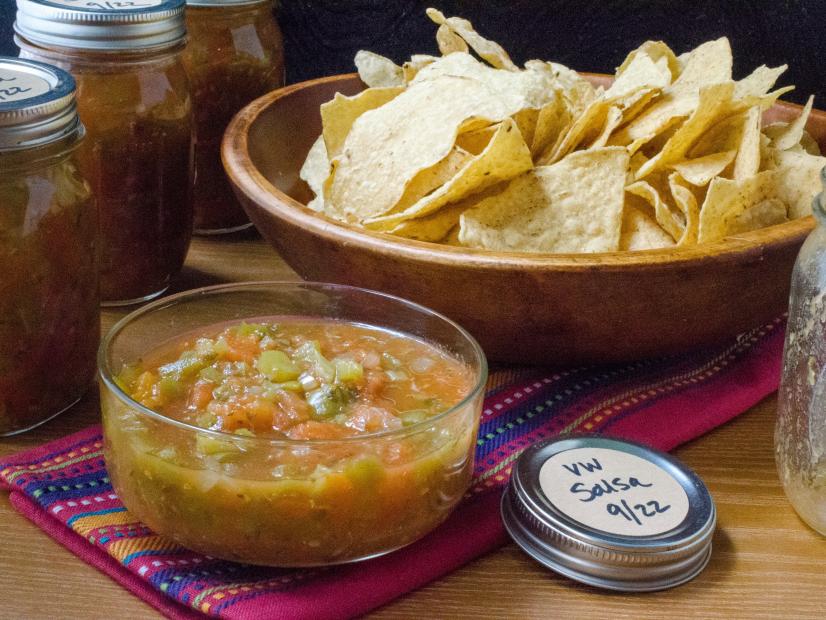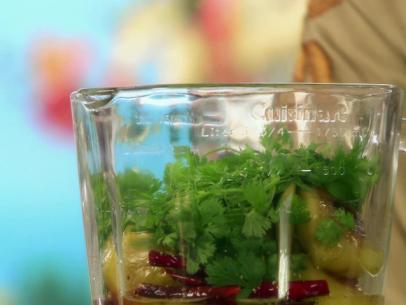
Easy Salsa for Canning
- Level: Easy
- Total: 1 hr
- Active: 30 min
- Yield: 4 pints
-
- Nutritional Analysis
- Per Serving
- Serving Size
- 1 of 4 servings
- Calories
- 285
- Total Fat
- 1 g
- Saturated Fat
- 0 g
- Carbohydrates
- 65 g
- Dietary Fiber
- 9 g
- Sugar
- 35 g
- Protein
- 5 g
- Cholesterol
- 0 mg
- Sodium
- 723 mg
- Level: Easy
- Total: 1 hr
- Active: 30 min
- Yield: 4 pints
-
- Nutritional Analysis
- Per Serving
- Serving Size
- 1 of 4 servings
- Calories
- 285
- Total Fat
- 1 g
- Saturated Fat
- 0 g
- Carbohydrates
- 65 g
- Dietary Fiber
- 9 g
- Sugar
- 35 g
- Protein
- 5 g
- Cholesterol
- 0 mg
- Sodium
- 723 mg
Ingredients
Directions
Special equipment:
a boiling water canner with a rack; canning tongs; canning funnel; four 1-pint canning jars- Place a wire rack in a rimmed baking sheet or line it with a clean towel. (This is to prevent the jars from directly touching the surface.) Set aside.
- Prepare the jars: It is not necessary to sterilize the jars beforehand if processing jars in a boiling water canner for 10 minutes or longer. The jars should instead be freshly cleaned and well washed in hot soapy water. Any jars processed less than 10 minutes must be pre-sterilized and the lids and rings placed into simmering, not boiling, water. Rings can be reused, but lids should be new and used only once for boiling water canning.
- Meanwhile, bring a pot of water to a boil. Use a paring knife to cut a small, shallow X in the bottom of each tomato (this is known as scoring). Prepare a bowl of ice water and set aside a slotted spoon or skimmer.
- One at a time using the slotted spoon, add the tomatoes to the boiling water. Let cook for 15 to 20 seconds, depending on the ripeness of the tomato, until the skins are just loosened. Transfer to the bowl of ice water to stop the cooking.
- As soon as the tomatoes are cool, remove them from the ice water. Use a paring knife to pull off the skin, starting at the X. The skin should now peel off quickly and easily. Core the tomatoes, then coarsely chop to 1/3-inch pieces or so. You will need 4 cups of coarsely chopped tomato.
- Place the chopped tomatoes in a pot with the peppers, onion, garlic and jalapeno. Add the vinegar, cilantro, salt, cumin and coriander. Stir to combine. Bring to a boil over high heat, then reduce the heat to a simmer. Cook until thickened and piping hot, about 20 minutes.
- When ready to can: For each jar, insert a canning funnel and carefully ladle in the salsa, allowing at least 1/4 inch of headroom. Clean the rims of the jars with a clean, damp towel and tightly secure the lids.
- Place the canning rack in the canner and fill the pot with water; bring to a boil over high heat. If you do not have a canning kettle, you can also place a metal rack or clean towel in the bottom of a large pot and bring to a boil.
- Using tongs, place the jars on the rack in the canner or in the prepared pot. The water should cover the jars by at least 1 inch. Cover the canner. Return the water to a boil and boil gently for 5 minutes (at altitudes less than 1,000 feet elevation; see Cook's Note). Using tongs, transfer the jars to a towel to cool. If the seal works and fits properly, the metal lid will be slightly concave within 24 hours of processing. Store the unopened jars of salsa at room temperature for up to 1 year. Once the salsa is opened, store in the refrigerator for 5 to 7 days.
Cook’s Note
For both 1/2-pints and pints, add 5 minutes processing time for altitudes between 1,001 to 6,000 feet elevation and 10 minutes processing time for altitudes above 6,000 feet elevation. High-acid foods such as fruits, pickles, sauerkraut, jams, jellies, marmalades and fruit butters with a pH level of 4.6 or lower can be preserved by boiling water canning (low-acid foods, such as canned meats and fish, require a pressure cooker). Boiling water canning makes use of a large pot that’s tall enough to fully submerge canning jars by at least an inch of water. The pot is used for both sterilization of jars prior to filling and for boiling the jars once they are filled. You don’t necessarily need to purchase a boiling water bath canner if you don’t already have one. Any large, deep stockpot equipped with a lid and a rack can double as a boiling water canner. Keep in mind: The pot must be large enough to fully surround and immerse the jars in water by 1 to 2 inches and allow for the water to boil rapidly with the lid on.
Looking for Something Else?
Related Pages
- Tailgate Chili Recipe
- Scalloped Potatoes Recipe
- Macaroni Salad Recipe
- Whole Roast Chicken with Lemon and Herbs Recipe
- Fried Catfish Recipe
- Low Country Shrimp and Grits with Stewed Tomatoes...
- Fresh Strawberry Jam for Canning Recipe
- Lightened-Up Pimiento Cheese Recipe
- Smothered and Covered Chicken and Gravy Recipe

































